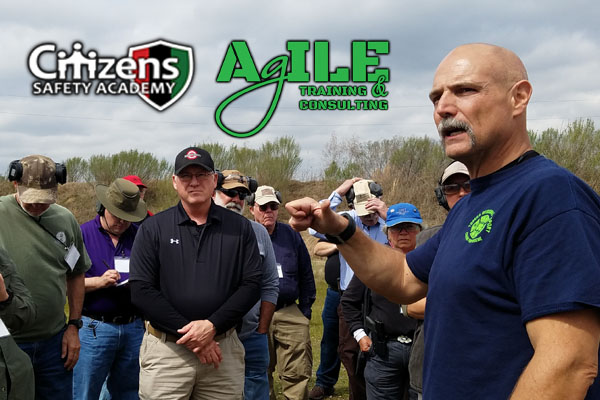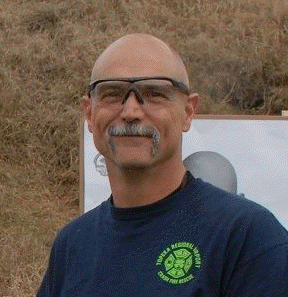CSA is excited to welcome Chuck Haggard of Agile Training and Consulting for this custom-designed course on techniques and tactics of using a concealed carry firearm in self-defense.
Agile Tactical Pistol (Chuck Haggard)

- This event has passed.
Agile Tactical Pistol (Chuck Haggard)
December 17, 2023 @ 8:00 am - 5:00 pm
$200
From Chuck Haggard:
This course is a one day distillation of the critical pistol skills that I have been teaching cops, military, and concealed carry/average earth people for a number of years.
This course will cover the tactical use of the semi auto pistol from close contact out to 25 yards, and the critical skills proven over the course of many years that are required to prevail in a fight AND pass review in court after the event.
Subject matter covered includes;
Grips, sights, trigger, and the interplay require to make fast and accurate hits at various ranges
Recoil control
Draw stroke
Malfunctions, the causes, and mitigation, TTPs required to stay in the fight
Alternative emergency sighting methods
Reloads
One and two handed shooting
Close quarters shooting techniques
Getting hits at distance
Tactical anatomy and the real world levels of accuracy required to achieve fight stopping hits
This class will include a recognized and scored law enforcement qualification course at the end
Student requirements;
This is NOT a basic handgun course. Students should already have enough training and experience to safely draw from a holster and be aware of muzzle direction/trigger finger.
A safe and reliable semi auto pistol, making sure it’s cleaned and lubricated ahead of time is a smart move, if you are using an optic please make sure you have fresh or spare batteries
Students may work from concealment or from open carry/duty belt as they choose.
A safe holster. This can be inside or outside the waistband. However the holster MUST allow reholstering repeatedly through the course, so soft leather or hybrid holsters (such as the popular Crossbreed) holsters that collapse are unsafe and unsuitable for the class.
Serpa holsters (and other such holsters that use a trigger finger to release the retention mechanism) are not allowed unless the student is a law enforcement officer using an issued duty style Serpa holster AND is required by agency policy to use this holster.
Clear eye protection (this is an indoor range) and hearing protection
At least three magazines for double stack pistols, six for single stack pistols such as 1911s, magazine pouch or pouches to allow at least one magazine to be reloaded quickly during specific drills (but two is better)
500 rounds of quality ammunition (this is not the time to save money and try out your Uncle Cheech’s reloaded garlic soaked heat seekers in order to save money, unreliable ammo will leave you both consistently behind and unhappy
 Chuck Haggard has been active in private defensive training throughout his long career in urban law enforcement. After nearly thirty years of steady upward progression through the ranks of the Topeka Police Department, he ventured out on his own to pursue private training on a more regular basis. Chuck maintains his POST certification and stays active in the law enforcement community, but he now devotes even more time to training other police officers, military personnel, security forces, and private citizens on the art and science of personal defense. Below is an abbreviated list of some of Chuck’s credentials.
Chuck Haggard has been active in private defensive training throughout his long career in urban law enforcement. After nearly thirty years of steady upward progression through the ranks of the Topeka Police Department, he ventured out on his own to pursue private training on a more regular basis. Chuck maintains his POST certification and stays active in the law enforcement community, but he now devotes even more time to training other police officers, military personnel, security forces, and private citizens on the art and science of personal defense. Below is an abbreviated list of some of Chuck’s credentials.
- 28+ years with the Topeka Police Department, including posts as a Field Training Officer, Field Training Supervisor, Rangemaster/Armorer, Response Team (SWAT) squad leader and team leader, and Watch Commander (rising to the rank of Lieutenant)
- Kansas Army National Guard (1985-1998)
- National Law Enforcement Training Center (NLETC), National Trainer
- Strategos International, Adjunct Instructor
- Survival Operations System, Inc., Instructor/Board of Directors
- Hardwire Tactical, Adjunct Instructor
- Countless training courses and train-the-trainer courses from various reputable sources, including:
- Rangemaster Firearms Training Services
- Defensive Shooting Academy of Tulsa
- HK International Law Enforcement Training Conference
- HSS International
- National Law Enforcement Training Center
- Israeli Shooting International
- Lethal Force Institute
- Strategos International
- Sure-Fire Institute
- Active Countermeasures Systems
- American Society of Law Enforcement Trainers
- Casco System (expandable baton)
- Glock Academy
- Safariland Training Group
- International Association of Law Enforcement Firearms Instructors
- National Rifle Association (several civilian and law enforcement instructor certifications)
- PPCT Training Systems
- Taser International
Chuck is certified as a civilian and law enforcement trainer on various weapon systems, including pistol, shotgun, rifle, carbine, oleoresin capsicum (O.C.), baton, and Taser. He is also skilled and experienced at teaching weapon retention, disarming, and other empty-hand techniques. He enjoys teaching and is proud to be able to contribute to this nation’s widespread community of responsible, law-abiding advocates of self-defense.
Contact Chuck at chuck@agiletactical.com.
What to Bring:
A safe and reliable semi auto pistol, making sure it’s cleaned and lubricated ahead of time is a smart move, if you are using an optic please make sure you have fresh or spare batteries
Students may work from concealment or from open carry/duty belt as they choose.
A safe holster. This can be inside or outside the waistband. However the holster MUST allow reholstering repeatedly through the course, so soft leather or hybrid holsters (such as the popular Crossbreed) holsters that collapse are unsafe and unsuitable for the class.
Serpa holsters (and other such holsters that use a trigger finger to release the retention mechanism) are not allowed unless the student is a law enforcement officer using an issued duty style Serpa holster AND is required by agency policy to use this holster.
Clear eye protection (this is an indoor range) and hearing protection
At least three magazines for double stack pistols, six for single stack pistols such as 1911s, magazine pouch or pouches to allow at least one magazine to be reloaded quickly during specific drills (but two is better)
500 rounds of quality ammunition (this is not the time to save money and try out your Uncle Cheech’s reloaded garlic soaked heat seekers in order to save money, unreliable ammo will leave you both consistently behind and unhappy)
This is an intermediate-level course. If you’re enrolling in this class, you should have a thorough understanding of the universal gun safety rules, and safe gun-handling skills should be second nature. You should also be thoroughly familiar with how your defensive handgun works and how to operate it.
Cost of the class is $200. Click here to register for the class.
To register for Chuck Haggard’s class, please click the image below to visit the Agile Training and Consulting Eventbrite Page. We hope to see you in class!

